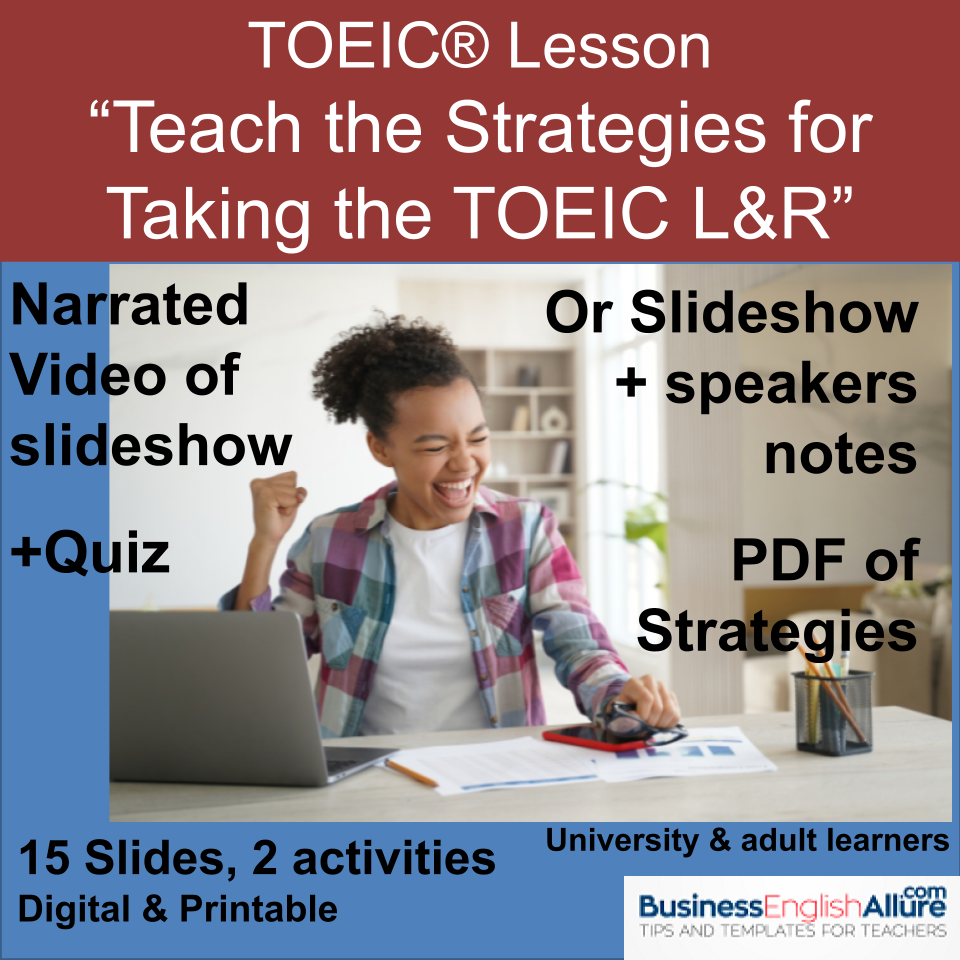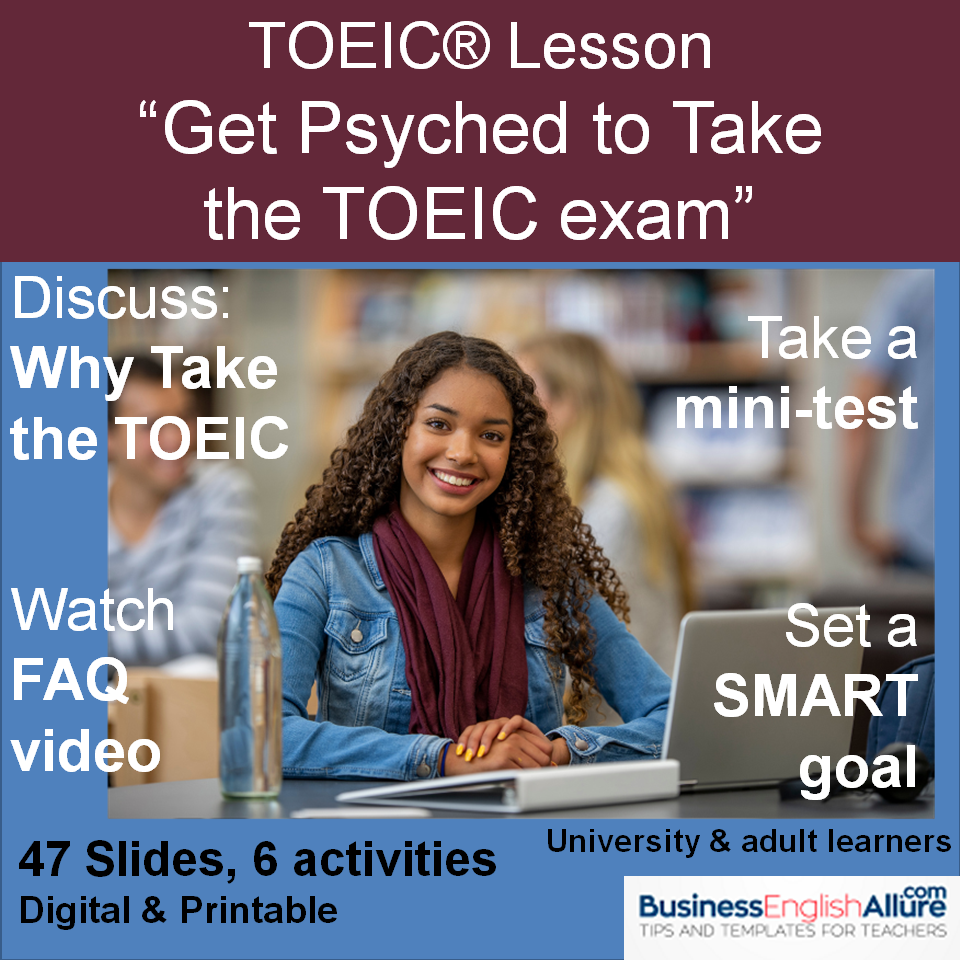What is the TOEIC test? All your questions answered

Over 6 million people take the TOEIC L&R test every year. Have you thought about suggesting it to your business English students? Learn about the different TOEIC tests offered by ETS with these nine FAQs answered for you. Watch this short YouTube video that you can show in class, then scroll down to be totally informed.
1. What is the TOEIC test?
The name TOEIC [pronounced toe-ick] means Test of English for International Communication. The keywords here are international communication. The test covers vocabulary and expressions used in an international workplace.
A high TOEIC score looks really good on a CV for non-native speakers applying for a job with a company that sells products internationally. Some international companies use it to measure qualifications for internal advancement. It can be a requirement for students as proof of English proficiency to graduate from or attend some universities.
Questions are designed to test the ability to understand and use English in work life situations with vocabulary and topics such as email, meetings, business travel and entertainment. It measures English proficiency with a score rather than simply a pass or fail result.
When most people talk about the TOEIC they are referring to the TOEIC Listening & Reading test. It lasts two hours and there are 200 multiple-choice questions. The TOEIC L&R is clearly the most popular and the most well-known with over 6 million test-takers every year.
There are also the complementary tests TOEIC Speaking and TOEIC Writing which can be taken together or separately. Taking all three TOEICs would give a clear picture of business English skills.
The TOEIC Bridge test is for English learners with a lower level of A1 or A2 (elementary and pre-intermediate).
2. Which TOEIC test should I take?

Out of the three TOEIC tests, take the Listening & Reading first.
Choose the TOEIC L&R test first. It is recognized by over 14,000 institutions (companies and universities) in over 160 countries. If you are required to take the Speaking and Writing tests then of course you will need to sign up and take those as well. But, in my opinion, get the L&R test out of the way. Listening and reading skills are always easier to improve, so your score may boost your self-confidence for the more difficult TOEIC Speaking and Reading tests.
Individuals who sign up for the TOEIC L&R test will choose a testing center and will surely take the paper-based test. The online version is reserved (for the moment Oct 2021) for institutions such as language schools, university classes, or companies testing large groups.
TOEIC was developed by the Educational Testing Service (ETS) in the United States in 1964. ETS is also the developer of the TOEFL exam (Test of English as a Foreign Language). Be sure to not confuse the two tests. The TOEIC measures workplace communication and its vocabulary whereas the TOEFL covers English for academics and the vocabulary of university life. Many universities require a certain TOEFL score for admissions but rarely do companies require it for hiring or advancement.
Download your free PDF of this blog and the YouTube video .
3. How difficult is the TOEIC?
The TOEIC L&R test is a difficult exam. Perhaps too difficult for anyone with a CEFR level lower than B1. Taking it before you have a B1 level would definitely be discouraging and maybe not even useful.
It measures the test takers’ knowledge of grammar, work-life vocabulary, and causal business expressions. There is a reading comprehension section that includes a short grammar section, then extensive questions from emails, business reports and articles from the press. The listening comprehension section covers short dialogues, announcements at events or for transportation, informal conversations at work or in a restaurant as well as more formal dialogues in meetings.
The listening section is tested first when test-takers are, luckily, more alert. It lasts 45 minutes and has 4 parts. The reading section takes 75 minutes and has three parts. The test is 50% reading comprehension (100 questions) and 50% listening comprehension (100 questions).
The listening section of the TOEIC L&R requires a great deal of concentration

Among the many reasons why the listening section is difficult are :
the 4 accents and the fact that workplace phrasal verbs are common.
There is very little time between questions and no time to go back and change an answer. It’s very easy to lose your place on the answer sheet. Even native speakers find it difficult to maintain concentration and remember all the facts from the listening passages.
The difficulty also lies in distinguishing words that sound alike, and having the time to read the listening comprehension questions before the listening passage starts.
One of the common challenges for non-native speakers is that the listening portions of the TOEIC contain four different accents.The different accents used on the test may prove to be difficult for students used to British accents. There are four accents: mainly American and Canadian, with some British and Australian.
It’s not the scholarly English that we are familiar with from classwork. It’s English in the workplace so there are a lot of phrasal verbs typically used in casual business conversation.
For the reading section the difficulty comes in not having enough time

The TOEIC reading section is hard to finish in 75 minutes.
Very few students finish the 100 questions. I’m a native speaker and studied all my life in the US yet I finished the test just 10 minutes early. I had to use every ounce of concentration I could muster to receive a perfect score.
I’ve found in my TOEIC preparation classes that most students will spend way too much time in the grammar section answering 25 multiple-choice grammar questions. Those should be done as quickly as possible so as not to waste too much time.
Many students have trouble understanding the comprehension questions and may need extra time to read thoroughly or reread passages before answering. Scanning and skimming skills in English are important here to quickly find obvious answers.
If you’re curious about your level take a free TOEIC mini-test here and get your CEFL level in less than one hour. /get-your-free-toeic-2018-mini-test/
4. What are the benefits of taking the TOEIC exam?

Taking the TOEIC and getting a good score is an achievement you can be proud of.
The TOEIC exam is a great way for students and professionals to show off their business English skills. It can also be a great way to get a job or promotion. Even if you don’t want to work in the business world, taking the exam is still an achievement that you can be proud of.
Some people think that the preparation for the exam is too time-consuming and expensive but it really depends on what your goals are. It’s important to take the TOEIC L&R because employers in many countries, especially in Asian countries such as China, Japan, Korea, and Vietnam assess applicants’ English skills before hiring them for jobs that require English. Some universities require the TOEIC for admission or for graduation.
5. What score should I have on the TOEIC?
The TOEIC measures proficiency so there is no pass or fail score. All levels of students take the TOEIC from beginner to advanced. There are many different factors that go into how high your score should be.
Some universities require a TOEIC L&R score of 785 just to graduate with an engineering degree. A score of 785 is equal to a B2 CEFR level or as some people say upper-intermediate.
Companies who require the TOEIC to hire applicants may ask for a score even higher than 785 because of competition for the position, your level of education and the industry you’re applying to could all be factors for higher score requirements.
It also depends on the position that you’re applying for. If you want to negotiate you need a high score of 900. If you want to work in sales with international clients you need 800 at least.
Here’s a chart which correlates the widely recognized CEFR levels (the Common European Framework of Reference for Languages) and a TOEIC L&R level. It’s from the ETS Global website.

Try for a combined score of 785. That’s a B2 level. That’s a good score and a good level.
6. How much does the TOEIC L&R test cost?
There is no set fee for the TOEIC L&R test. The price is set by the testing centers. It ranges from $100 to $200 US dollars depending on the country and the type of test taken. For example, here in France where I live, the TOEIC L&R costs around $135 for an individual to signup and take the test in a testing center. ETS calls this the Public Programme.
For the TOEIC Speaking & Writing which are online exams, the price is around at $160.
Use this link at ETSglobal.org to read the instructions on how to choose a test and the testing center near you. The link will recognize your country from your IP address. //www.etsglobal.org/nc/en/landing-page/register-to-a-toeic-test
For group signups, which ETS calls the Institutional Programme, the company, language school or university will organize and pay for your first test. If you’d like a printed certificate, that will cost around $25. You can also opt-in for express grading to get your results back within 3 or 4 days. Since September 2021 you can obtain your official score report online. No more nervously waiting for the postman to deliver your results. Read about it here.
7. Where can I take the TOEIC?
The TOEIC L&R test is available at over 1000 locations worldwide. Use this link at ETSglobal.org to read the instructions on how to choose a test and the testing center near you. The link will recognize your country from your IP address. //www.etsglobal.org/nc/en/landing-page/register-to-a-toeic-test
Can I take it online? Yes, but there are restrictions. ETS calls it the Institutional Program. It has exactly the same characteristics as the paper-based test. Institutions, such as universities and companies can organise an online test where students or employees can take it from home with a proctor monitoring via a webcam.
8. How do I prepare for the TOEIC exam.
Do as many practice tests as possible. You can find free ones illegally uploaded online all over YouTube. Just take note that the test was updated in 2018 and many of those tests are out-of-date. Why not read this blog post of mine on the changes to the 2018 version? You will learn how to recognize an outdated test online and see how the test is organized into 7 parts. There’s a video of highlights from the article you can watch, and if you scroll down to the end of the article you will find my recommendations for three different TOEIC course books with updated practice tests.
Build your vocabulary by reading the newspaper and magazines but stick to workplace topics. Revise grammar points you missed on the practice tests but don’t waste too much time on grammar. Vocabulary is 75% of the test.
What topics does the TOEIC exam cover? Toeic topics could include business travel, finance, health, housing, banking, entertainment, offices, shopping, restaurants, travel, transportation. Teachers check out this blog post of mine for the top 10 topics to choose for your preparation class. /focus-on-top-toeic-topics-in-class/
Here is a pdf of the ETS official Student Handbook from 2019 that you can download and hopefully read. You’ll find on page three a list of all the workplace contexts (topics) that might be covered in the TOEIC L&R.
9. What are the pros and cons of the TOEIC L&R exam?
Cons: It’s very difficult and expensive. Anyone can take the test but I would recommend a B1 level before attempting the TOEIC L&R. You can, however, take it as many times as you want, but remember it does cost around $135 (2021 price in France). The test does not cover all four communication skills, only listening and reading comprehension. The TOEIC Speaking & Writing exams are sold and taken separately.
Pros: It is very well-known and respected by HR managers working for international companies across the globe.
Leave a comment if you liked this post. Signup for the newsletter if you want to receive more posts.
I’ve got a store on TeachersPayTeachers.com

Introduction to the TOEIC ready-made lesson
You can also find the FAQs video included in this comprehensive introduction to the TOEIC L&R lesson.
You’ll get: ● 47 slides with speaker notes ● Guessing activity “4 Reasons why 6 million people take the TOEIC” ● Video with activity: TOEIC FAQs ● Pick a target TOEIC score to aim for based on average scores for your country or region.● Take a 45m mini-test answers provided plus test-taking strategies for Parts 1-7● Calculate the number of study hours needed to reach the target score
Buy this ready-made TOEIC lesson plan on “TOEIC Lesson Plan: How to Set a Target Score and SMART Goal.” Just $5 for a 6-hour lesson. Pay with PayPal. Digital & printable versions.











